高中英语五种基本句型课件(含练习及答案 )
文档属性
| 名称 | 高中英语五种基本句型课件(含练习及答案 ) |  | |
| 格式 | zip | ||
| 文件大小 | 2.1MB | ||
| 资源类型 | 教案 | ||
| 版本资源 | 通用版 | ||
| 科目 | 英语 | ||
| 更新时间 | 2020-12-02 11:09:38 | ||
图片预览

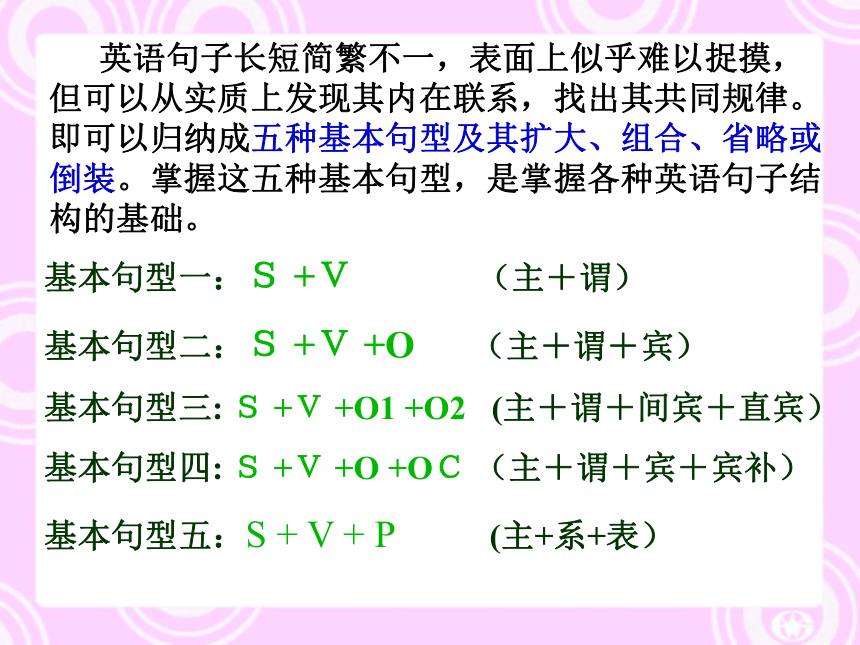

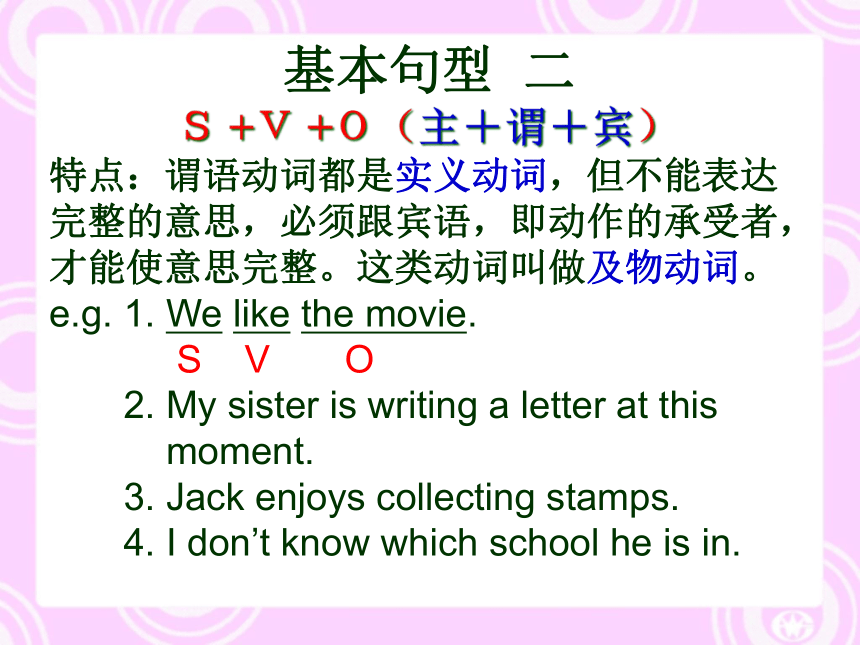
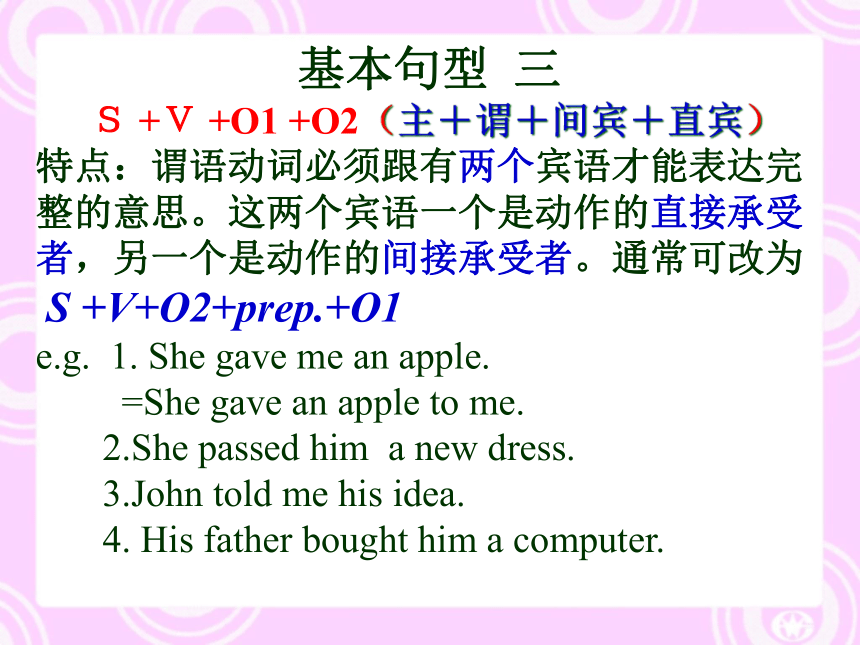
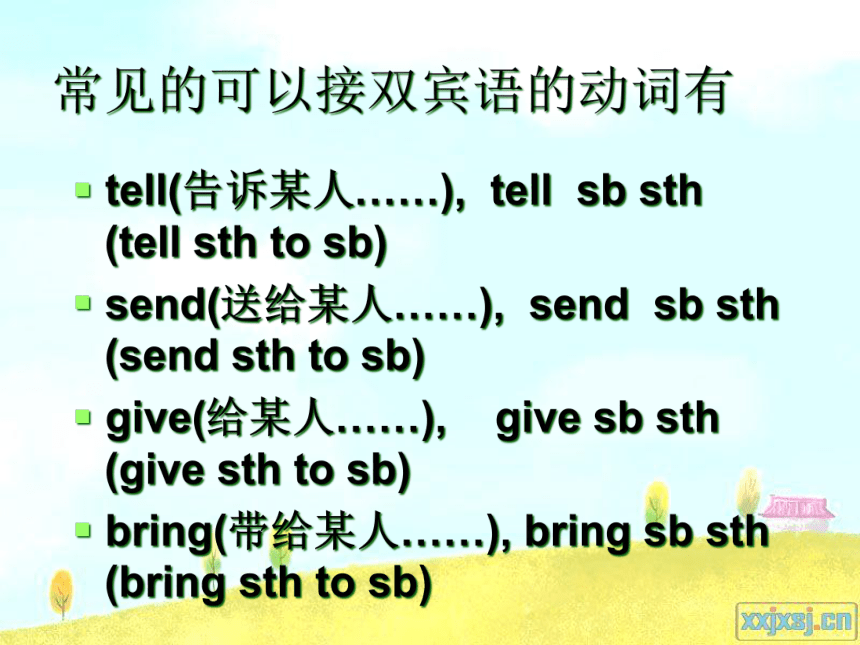

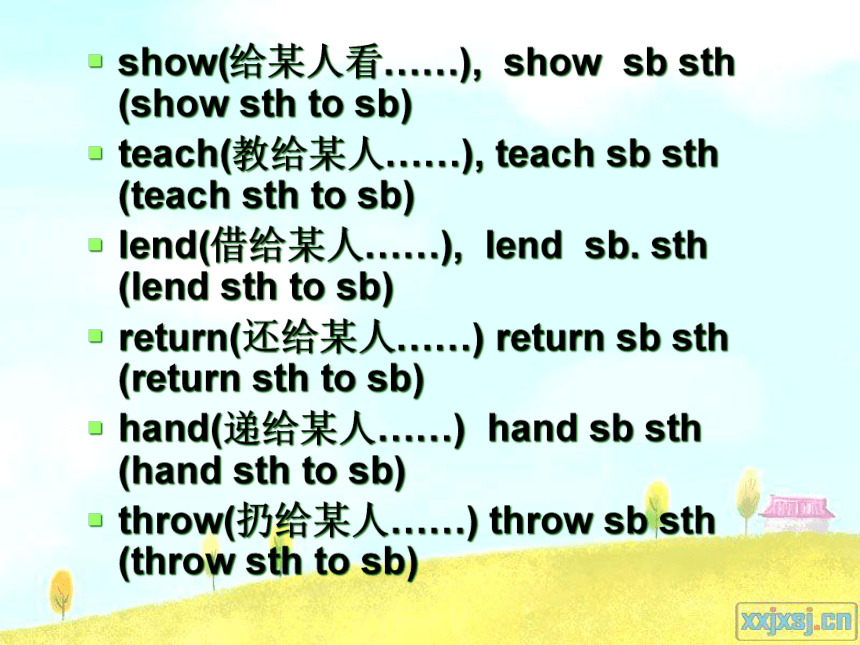

文档简介
(共28张PPT)
英语五种基本句型
英语句子长短简繁不一,表面上似乎难以捉摸,但可以从实质上发现其内在联系,找出其共同规律。即可以归纳成五种基本句型及其扩大、组合、省略或倒装。掌握这五种基本句型,是掌握各种英语句子结构的基础。
基本句型一:S+V(主+谓)
基本句型二:S+V+O(主+谓+宾)
基本句型三:S+V+O1+O2(主+谓+间宾+直宾)
基本句型四:S+V+O+OC(主+谓+宾+宾补)
基本句型五:S+V+P(主+系+表)基本句型一
S(subject)+V(verb)(主+谓)
特点:句子的谓语动词都能表达完整的意思
这类动词叫做不及物动词,后面可以跟副词、介词短语、状语从句等。
e.g.1.His words works.
S
V
2.My
grandma
is
sleeping
now.
3.I
will
stay
in
Shanghai
for
a
week.
4.Lucy
arrived
in
Beijing
yesterday
基本句型
二
S
+V
+O(主+谓+宾)
特点:谓语动词都是实义动词,但不能表达完整的意思,必须跟宾语,即动作的承受者,才能使意思完整。这类动词叫做及物动词。
e.g.
1.
We
like
the
movie.
S
V
O
2.
My
sister
is
writing
a
letter
at
this
moment.
3.
Jack
enjoys
collecting
stamps.
4.
I
don’t
know
which
school
he
is
in.
基本句型
三
S
+V
+O1
+O2(主+谓+间宾+直宾)
特点:谓语动词必须跟有两个宾语才能表达完
整的意思。这两个宾语一个是动作的直接承受
者,另一个是动作的间接承受者。通常可改为
S
+V+O2+prep.+O1
e.g.
1.
She
gave
me
an
apple.
=She
gave
an
apple
to
me.
2.She
passed
him
a
new
dress.
3.John
told
me
his
idea.
4.
His
father
bought
him
a
computer.
常见的可以接双宾语的动词有
tell(告诉某人……),??tell??sb
sth
(tell
sth
to
sb)
send(送给某人……),??send??sb
sth
(send
sth
to
sb)
give(给某人……),
give
sb
sth
(give
sth
to
sb)
bring(带给某人……),
bring?sb
sth
(bring
sth
to
sb)
leave(留给某人……),
leave
sb
sth
(leave
sth
to
sb)
pass(递给某人……),??pass??sb
sth
(pass
sth
to
sb)
read(给某人读……),??read??sb
sth
(read
sth
to
sb)
write(给某人写……),
write
sb
sth
(write
sth
to
sb)
take(给某人拿……),??take??sb
sth
(take
sth
to
sb)
show(给某人看……),??show??sb
sth
(show
sth
to
sb)
teach(教给某人……),
teach
sb
sth
(teach
sth
to
sb)
lend(借给某人……),??lend??sb.
sth
(lend
sth
to
sb)
return(还给某人……)
return
sb
sth
(return
sth
to
sb)
hand(递给某人……)
hand?sb
sth
(hand
sth
to
sb)
throw(扔给某人……)
throw
sb
sth
(throw
sth
to
sb)
get(为某人弄到……),
get?sb
sth?
(get
sth
for
sb)
pay(支付给某人……),
pay?sb
sth
(pay
sth
for
sb)
buy(为某人买……),??
buy?sb
sth
(buy
sth
for
sb)
do(为某人做……)
do
sb
sth
(do
sth
for
sb)
sing(为某人唱……)
sing
sb
sth
(sing
sth
for
sb)
play(为某人演奏……)
play
sb
sth
(play
sth
for
sb)
cook(为某人煮……)
cook
sb
sth
(cook
sth
for
sb)
choose(为某人选择……)
choose
sb
sth
(choose
sth
for
sb)
make(为某人做……)
make
sb
sth
(make
sth
for
sb)
save(为某人留……)
save
sb
sth
(save
sth
for
sb)
fetch(为某人去取……)
fetch
sb
sth
(fetch
sth
for
sb)
基本句型
四
S
+V
+O
+OC(主+谓+宾+宾补)
特点:动词虽然是及物动词,但是只跟一个宾
语还不能表达完整的意思,必须加上一个补充成分来补足宾语,才能使意思完整。
判断原则:能表达成—宾语
是…/做…
e.g.
1.We
made
him
the
manager.
S
V
O
OC
2.
We
must
keep
the
classroom
clean.
3.
They
consider
Jack
a
brave
boy.
4.
Lucy
will
make
herself
known.
5.
I
saw
the
little
girl
dancing.
基本句型
五
S
+V
+P(主+系+表)
特点:句子谓语动词都不能表达一个完整的意
思,必须加上一个表明主语身份或状态的表语构
成复合谓语,才能表达完整的意思。这类动词叫
做(连)系动词。
e.g.
1.This
is
an
English
dictionary.
S
V
P
2.Everything
looks
different.
3.The
weather
becomes
cooler.
常见的系动词:
可分四类:
1)be动词am,
is,
are,
was,
were,
being,
been,
be
等
;
2)感官动词类
look,
feel,
smell,
taste,
sound等
3)表示变化:get,
grow,
become,
turn,
go等
4)表示状态延续:stay,
keep,
remain,
stand等。
巩固练习
1.Plants
need
water.
S+V+O
(
主
+
谓+
宾
)
2.The
flower
is
so
fresh.
S
+V
+P
(主
+
系
+
表)
3.They
work
hard.
S
+V
(主
+
谓
)
4.He
gives
me
some
seeds.
S
+V
+In
O
+
DO
(主
+
谓
+
直宾
+
间宾)
5.We
should
keep
the
plants
in
the
shade.
S+V
+O
+OC
(主
+
谓
+
宾
+
宾补)
6.Many
animals
live
in
trees.
S
+
V
(主
+
谓)
翻译练习:
春天时公园看起来很漂亮。
The
park
looks
beautiful
in
spring.
老师答应过和我们去看电影。
Our
teacher
promised
to
see
the
movie
with
us.
昨天我送了生日礼物给她。
I
sent
a
birthday
gift
to
her
yesterday.
我们必须保证教室整洁。
We
must
keep
the
classroom
clean.
男孩发现他的笔在地上。
The
boy
found
his
pen
on
the
floor.
在句子中词类和词的位置也影响句子的句型和意思:
I
found
the
book
easily.
我很容易地找到了这本书。(
S
V
O
)
I
found
the
book
easy.
我觉得这本书很容易。
(S
V
O
C)
按结构英语句子主要可以分成三种:
简单句,
并列句,复合句
e.g.
1)
The
teacher’s
name
is
Smith.
2)
The
teacher’s
name
is
Smith
and
the
student’s
name
is
John.
3)
He
is
Smith
who
likes
going
hiking.
4)
He
is
Smith
and
he
likes
going
hiking.
5)
Hurry
up,
or
you’ll
be
late.
6)
I
saw
him
when
I
walked
past
the
street.
7)
He
often
gets
up
early
because
he
wants
to
catch
the
early
bus.
简单句
并列句
复合句
并列句
并列句
复合句
复合句
基本句型的扩展:
e.g.
We
found
the
hall
full.
我们发现礼堂坐满了。
We
found
the
great
hall
full
of
students
and
teachers.
我们发现大礼堂坐满了老师和学生。
We
found
the
great
hall
full
of
students
and
teachers
who
were
listening
to
an
important
report.
我们发现大礼堂坐满了学生和教师,在听一个重要报告。
We
found
the
great
hall
full
of
students
and
teachers
who
were
listening
to
an
important
report
我们发现大礼堂坐满了学生和教师,在听人民日报的一位记者作有关东欧目前局势的重要报告。
made
by
a
reporter
from
the
People's
Daily
about
current
affairs
in
East
Europe.
_________________
翻译:我们发现大礼堂坐满了学生和教师,在听人民日报的一位同志作有关东欧目前局势的重要报告。
???分析结构:
我们
发现(谓语)
大
礼堂
full
of
学生和老师(复数)
who
在听(谓语)重要
报告
made
by
一位同志
from
人民日报
about
目前局势
in
东欧。
We
found
the
great
hall
full
of
students
and
teachers
who
were
listening
to
an
important
report
made
by
a
reporter
from
the
People's
Daily
about
current
affairs
in
East
Europe.
总结:遇到长句子的翻译不着急,动笔前,仔细阅读原句,确切理解原句内容,抓住中心,搞清楚各部分之间关系,把句子缩小再缩小,缩小到只剩下五个基本句型中的主要成分,先心译,再笔译,心译过程中,要有句子时态规划,名词单复数等盘算,然后再一步步扩大句子,添加修饰成分,直至完整,再笔译。这种方法叫做孙悟空变金箍棒的方法:缩小缩小再缩小,放大放大再放大。
练习翻译:王国平从北京大学毕业之前,他给在北京一家医院工作的爸爸写了一封信,问他是否愿意让他出国。
???分析结构:
before
他graduate
from
北京大学,
王国平
写了(谓语)一封信
to
爸爸,
who
在医院工作
in
北京,
asking
(非谓语)他是否愿意让他出国
Before
he
graduated
from
Beijing
University,
Wang
Guoping
wrore
a
letter
to
his
father,
who
works
at
a
hospital
in
Beijing,
asking
if
he
would
like
him
to
go
abroad.
练习翻译:就在我们毕业于北京大学之前,罗校长为我们做了一次演讲,要求我们到偏远山区去工作。
???分析结构:
before
我们graduate
from
北京大学,
罗校长
做了(谓语)一次演讲
for
我们,
requiring(非谓语)我们to
工作
in
偏远山区。
Before
we
graduated
from
Beijing
University,
principal
Luo
made
a
speech
for
us,
requiring
us
to
go
to
work
in
distant
mountainous
areas.
练习翻译:After
the
meeting
all
the
students
wrote
to
their
parents
who
works
in
the
big
cities,
asking
if
they
agree
that
they
choose
to
work
in
the
distant
mountainous
areas.
会后,所有学生们都给
在大城市工作的父母
写了一封信,
问他们是否同意
他们选择去偏远山区工作。
练习翻译:Three
years
later,
most
students
wrote
a
letter
to
principal
Luo
who
works
at
a
hospital
in
Germany,
saying
that
they
were
willing
to
continue
working
in
the
distant
mountainous
areas
and
asking
principal
Luo
to
come
back
to
have
a
visit
if
it
is
convenient.
三年后,大多数的学生给
在德国一家医院工作的罗校长
写了一封信
说他们愿意继续在偏远山区工作
并邀请罗校长如果有空就回国来看看。
各种词类及其在句子中的作用:
1.
Nouns
(n.)
名词:
-----主语(S),宾语(O),表语(P)等
2.
Verbs
(v.)
动词
----谓语(V)
(
vt.
及物动词
/
vi.
不及物动词)
3.
Pronouns
(pron.)
代词:
----主语,宾语,表语等
e.g.
Kate
has
a
piano.
She
likes
it
very
much.
____
S
___
V
_______
O
___
S
___
V
__
O
4.
Adjectives
(adj.)
形容词:
----定语(At.)
表语
(P)
e.g.
The
overcoat
is
very
beautiful.
This
is
a
very
beautiful
overcoat.
5.
Adverbs
(adv.)
副词:------状语(Ad.)
6.
Numerals
(num.)
数词:
------定语,表语,主语等
e.g.
25
(desks)
______(be)
enough.
7.
Articles
(art.)
冠词:
一般不单独构成句子成分
(At.)
(P)
is
8.
Prepositions
(prep.)
介词(in,
at,
on,
…)
prep.
+n.
介词短语-----状语
(Ad.),表语等
e.g.
We
can
see
the
bike
under
the
tree.
9.
Conjunctions
(conj.)
连词
(
and,
or,
but,
so…)
一般不构成成分,仅起连接作用
10.
Interjections
(
interj.)
感叹词
(ah,
oh,
yeah…)
一般不构成成分,起加强语气作用
英语五种基本句型
英语句子长短简繁不一,表面上似乎难以捉摸,但可以从实质上发现其内在联系,找出其共同规律。即可以归纳成五种基本句型及其扩大、组合、省略或倒装。掌握这五种基本句型,是掌握各种英语句子结构的基础。
基本句型一:S+V(主+谓)
基本句型二:S+V+O(主+谓+宾)
基本句型三:S+V+O1+O2(主+谓+间宾+直宾)
基本句型四:S+V+O+OC(主+谓+宾+宾补)
基本句型五:S+V+P(主+系+表)基本句型一
S(subject)+V(verb)(主+谓)
特点:句子的谓语动词都能表达完整的意思
这类动词叫做不及物动词,后面可以跟副词、介词短语、状语从句等。
e.g.1.His words works.
S
V
2.My
grandma
is
sleeping
now.
3.I
will
stay
in
Shanghai
for
a
week.
4.Lucy
arrived
in
Beijing
yesterday
基本句型
二
S
+V
+O(主+谓+宾)
特点:谓语动词都是实义动词,但不能表达完整的意思,必须跟宾语,即动作的承受者,才能使意思完整。这类动词叫做及物动词。
e.g.
1.
We
like
the
movie.
S
V
O
2.
My
sister
is
writing
a
letter
at
this
moment.
3.
Jack
enjoys
collecting
stamps.
4.
I
don’t
know
which
school
he
is
in.
基本句型
三
S
+V
+O1
+O2(主+谓+间宾+直宾)
特点:谓语动词必须跟有两个宾语才能表达完
整的意思。这两个宾语一个是动作的直接承受
者,另一个是动作的间接承受者。通常可改为
S
+V+O2+prep.+O1
e.g.
1.
She
gave
me
an
apple.
=She
gave
an
apple
to
me.
2.She
passed
him
a
new
dress.
3.John
told
me
his
idea.
4.
His
father
bought
him
a
computer.
常见的可以接双宾语的动词有
tell(告诉某人……),??tell??sb
sth
(tell
sth
to
sb)
send(送给某人……),??send??sb
sth
(send
sth
to
sb)
give(给某人……),
give
sb
sth
(give
sth
to
sb)
bring(带给某人……),
bring?sb
sth
(bring
sth
to
sb)
leave(留给某人……),
leave
sb
sth
(leave
sth
to
sb)
pass(递给某人……),??pass??sb
sth
(pass
sth
to
sb)
read(给某人读……),??read??sb
sth
(read
sth
to
sb)
write(给某人写……),
write
sb
sth
(write
sth
to
sb)
take(给某人拿……),??take??sb
sth
(take
sth
to
sb)
show(给某人看……),??show??sb
sth
(show
sth
to
sb)
teach(教给某人……),
teach
sb
sth
(teach
sth
to
sb)
lend(借给某人……),??lend??sb.
sth
(lend
sth
to
sb)
return(还给某人……)
return
sb
sth
(return
sth
to
sb)
hand(递给某人……)
hand?sb
sth
(hand
sth
to
sb)
throw(扔给某人……)
throw
sb
sth
(throw
sth
to
sb)
get(为某人弄到……),
get?sb
sth?
(get
sth
for
sb)
pay(支付给某人……),
pay?sb
sth
(pay
sth
for
sb)
buy(为某人买……),??
buy?sb
sth
(buy
sth
for
sb)
do(为某人做……)
do
sb
sth
(do
sth
for
sb)
sing(为某人唱……)
sing
sb
sth
(sing
sth
for
sb)
play(为某人演奏……)
play
sb
sth
(play
sth
for
sb)
cook(为某人煮……)
cook
sb
sth
(cook
sth
for
sb)
choose(为某人选择……)
choose
sb
sth
(choose
sth
for
sb)
make(为某人做……)
make
sb
sth
(make
sth
for
sb)
save(为某人留……)
save
sb
sth
(save
sth
for
sb)
fetch(为某人去取……)
fetch
sb
sth
(fetch
sth
for
sb)
基本句型
四
S
+V
+O
+OC(主+谓+宾+宾补)
特点:动词虽然是及物动词,但是只跟一个宾
语还不能表达完整的意思,必须加上一个补充成分来补足宾语,才能使意思完整。
判断原则:能表达成—宾语
是…/做…
e.g.
1.We
made
him
the
manager.
S
V
O
OC
2.
We
must
keep
the
classroom
clean.
3.
They
consider
Jack
a
brave
boy.
4.
Lucy
will
make
herself
known.
5.
I
saw
the
little
girl
dancing.
基本句型
五
S
+V
+P(主+系+表)
特点:句子谓语动词都不能表达一个完整的意
思,必须加上一个表明主语身份或状态的表语构
成复合谓语,才能表达完整的意思。这类动词叫
做(连)系动词。
e.g.
1.This
is
an
English
dictionary.
S
V
P
2.Everything
looks
different.
3.The
weather
becomes
cooler.
常见的系动词:
可分四类:
1)be动词am,
is,
are,
was,
were,
being,
been,
be
等
;
2)感官动词类
look,
feel,
smell,
taste,
sound等
3)表示变化:get,
grow,
become,
turn,
go等
4)表示状态延续:stay,
keep,
remain,
stand等。
巩固练习
1.Plants
need
water.
S+V+O
(
主
+
谓+
宾
)
2.The
flower
is
so
fresh.
S
+V
+P
(主
+
系
+
表)
3.They
work
hard.
S
+V
(主
+
谓
)
4.He
gives
me
some
seeds.
S
+V
+In
O
+
DO
(主
+
谓
+
直宾
+
间宾)
5.We
should
keep
the
plants
in
the
shade.
S+V
+O
+OC
(主
+
谓
+
宾
+
宾补)
6.Many
animals
live
in
trees.
S
+
V
(主
+
谓)
翻译练习:
春天时公园看起来很漂亮。
The
park
looks
beautiful
in
spring.
老师答应过和我们去看电影。
Our
teacher
promised
to
see
the
movie
with
us.
昨天我送了生日礼物给她。
I
sent
a
birthday
gift
to
her
yesterday.
我们必须保证教室整洁。
We
must
keep
the
classroom
clean.
男孩发现他的笔在地上。
The
boy
found
his
pen
on
the
floor.
在句子中词类和词的位置也影响句子的句型和意思:
I
found
the
book
easily.
我很容易地找到了这本书。(
S
V
O
)
I
found
the
book
easy.
我觉得这本书很容易。
(S
V
O
C)
按结构英语句子主要可以分成三种:
简单句,
并列句,复合句
e.g.
1)
The
teacher’s
name
is
Smith.
2)
The
teacher’s
name
is
Smith
and
the
student’s
name
is
John.
3)
He
is
Smith
who
likes
going
hiking.
4)
He
is
Smith
and
he
likes
going
hiking.
5)
Hurry
up,
or
you’ll
be
late.
6)
I
saw
him
when
I
walked
past
the
street.
7)
He
often
gets
up
early
because
he
wants
to
catch
the
early
bus.
简单句
并列句
复合句
并列句
并列句
复合句
复合句
基本句型的扩展:
e.g.
We
found
the
hall
full.
我们发现礼堂坐满了。
We
found
the
great
hall
full
of
students
and
teachers.
我们发现大礼堂坐满了老师和学生。
We
found
the
great
hall
full
of
students
and
teachers
who
were
listening
to
an
important
report.
我们发现大礼堂坐满了学生和教师,在听一个重要报告。
We
found
the
great
hall
full
of
students
and
teachers
who
were
listening
to
an
important
report
我们发现大礼堂坐满了学生和教师,在听人民日报的一位记者作有关东欧目前局势的重要报告。
made
by
a
reporter
from
the
People's
Daily
about
current
affairs
in
East
Europe.
_________________
翻译:我们发现大礼堂坐满了学生和教师,在听人民日报的一位同志作有关东欧目前局势的重要报告。
???分析结构:
我们
发现(谓语)
大
礼堂
full
of
学生和老师(复数)
who
在听(谓语)重要
报告
made
by
一位同志
from
人民日报
about
目前局势
in
东欧。
We
found
the
great
hall
full
of
students
and
teachers
who
were
listening
to
an
important
report
made
by
a
reporter
from
the
People's
Daily
about
current
affairs
in
East
Europe.
总结:遇到长句子的翻译不着急,动笔前,仔细阅读原句,确切理解原句内容,抓住中心,搞清楚各部分之间关系,把句子缩小再缩小,缩小到只剩下五个基本句型中的主要成分,先心译,再笔译,心译过程中,要有句子时态规划,名词单复数等盘算,然后再一步步扩大句子,添加修饰成分,直至完整,再笔译。这种方法叫做孙悟空变金箍棒的方法:缩小缩小再缩小,放大放大再放大。
练习翻译:王国平从北京大学毕业之前,他给在北京一家医院工作的爸爸写了一封信,问他是否愿意让他出国。
???分析结构:
before
他graduate
from
北京大学,
王国平
写了(谓语)一封信
to
爸爸,
who
在医院工作
in
北京,
asking
(非谓语)他是否愿意让他出国
Before
he
graduated
from
Beijing
University,
Wang
Guoping
wrore
a
letter
to
his
father,
who
works
at
a
hospital
in
Beijing,
asking
if
he
would
like
him
to
go
abroad.
练习翻译:就在我们毕业于北京大学之前,罗校长为我们做了一次演讲,要求我们到偏远山区去工作。
???分析结构:
before
我们graduate
from
北京大学,
罗校长
做了(谓语)一次演讲
for
我们,
requiring(非谓语)我们to
工作
in
偏远山区。
Before
we
graduated
from
Beijing
University,
principal
Luo
made
a
speech
for
us,
requiring
us
to
go
to
work
in
distant
mountainous
areas.
练习翻译:After
the
meeting
all
the
students
wrote
to
their
parents
who
works
in
the
big
cities,
asking
if
they
agree
that
they
choose
to
work
in
the
distant
mountainous
areas.
会后,所有学生们都给
在大城市工作的父母
写了一封信,
问他们是否同意
他们选择去偏远山区工作。
练习翻译:Three
years
later,
most
students
wrote
a
letter
to
principal
Luo
who
works
at
a
hospital
in
Germany,
saying
that
they
were
willing
to
continue
working
in
the
distant
mountainous
areas
and
asking
principal
Luo
to
come
back
to
have
a
visit
if
it
is
convenient.
三年后,大多数的学生给
在德国一家医院工作的罗校长
写了一封信
说他们愿意继续在偏远山区工作
并邀请罗校长如果有空就回国来看看。
各种词类及其在句子中的作用:
1.
Nouns
(n.)
名词:
-----主语(S),宾语(O),表语(P)等
2.
Verbs
(v.)
动词
----谓语(V)
(
vt.
及物动词
/
vi.
不及物动词)
3.
Pronouns
(pron.)
代词:
----主语,宾语,表语等
e.g.
Kate
has
a
piano.
She
likes
it
very
much.
____
S
___
V
_______
O
___
S
___
V
__
O
4.
Adjectives
(adj.)
形容词:
----定语(At.)
表语
(P)
e.g.
The
overcoat
is
very
beautiful.
This
is
a
very
beautiful
overcoat.
5.
Adverbs
(adv.)
副词:------状语(Ad.)
6.
Numerals
(num.)
数词:
------定语,表语,主语等
e.g.
25
(desks)
______(be)
enough.
7.
Articles
(art.)
冠词:
一般不单独构成句子成分
(At.)
(P)
is
8.
Prepositions
(prep.)
介词(in,
at,
on,
…)
prep.
+n.
介词短语-----状语
(Ad.),表语等
e.g.
We
can
see
the
bike
under
the
tree.
9.
Conjunctions
(conj.)
连词
(
and,
or,
but,
so…)
一般不构成成分,仅起连接作用
10.
Interjections
(
interj.)
感叹词
(ah,
oh,
yeah…)
一般不构成成分,起加强语气作用
